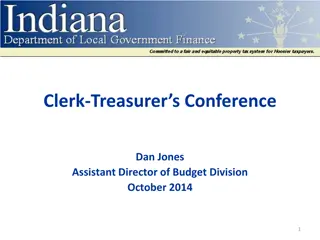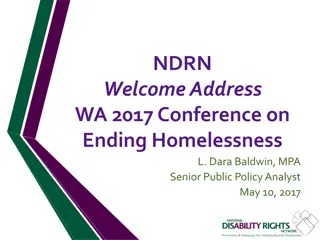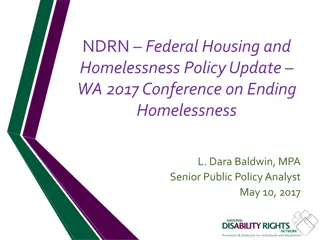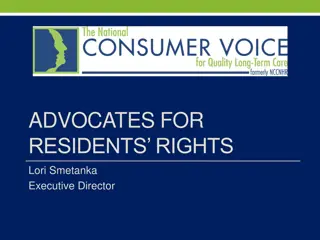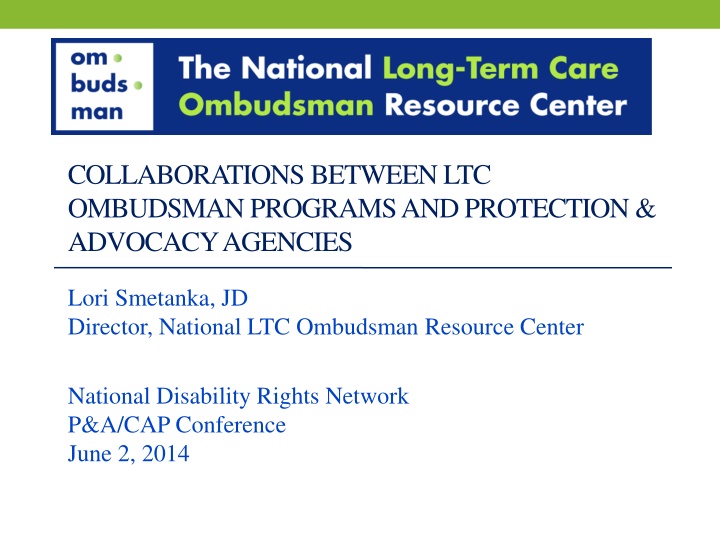
Collaborations between LTC Ombudsman Programs and Protection & Advocacy Agencies
Explore the collaborative efforts between LTC Ombudsman Programs and Protection & Advocacy Agencies in addressing concerns, resolving complaints, and advocating for the rights of residents in long-term care facilities. Learn about the roles of Ombudsman Resource Centers and the key activities of Long-Term Care Ombudsman Programs in promoting quality care and upholding dignity. Discover how Advocate Ombudsmen work impartially to seek resolutions while adhering to strict confidentiality standards set by the Older Americans Act.
Download Presentation

Please find below an Image/Link to download the presentation.
The content on the website is provided AS IS for your information and personal use only. It may not be sold, licensed, or shared on other websites without obtaining consent from the author. If you encounter any issues during the download, it is possible that the publisher has removed the file from their server.
You are allowed to download the files provided on this website for personal or commercial use, subject to the condition that they are used lawfully. All files are the property of their respective owners.
The content on the website is provided AS IS for your information and personal use only. It may not be sold, licensed, or shared on other websites without obtaining consent from the author.
E N D
Presentation Transcript
COLLABORATIONS BETWEEN LTC OMBUDSMAN PROGRAMS AND PROTECTION & ADVOCACY AGENCIES Lori Smetanka, JD Director, National LTC Ombudsman Resource Center National Disability Rights Network P&A/CAP Conference June 2, 2014
Ombudsman Resource Center Funded by the Administration for Community Living/Administration on Aging Provides technical assistance, training, and support to State and Local LTC Ombudsman Programs nationwide Housed at the National Consumer Voice for Quality Long-Term Care
Long-Term Care Ombudsman Program Developed as a response to poor care and conditions in nursing homes 1978 All States required to establish an Office of the Long- Term Care Ombudsman Nursing Homes, Board & Care Facilities, Assisted Living Facilities, Home Care (limited)
Long-Term Care Ombudsman Program 53 State LTC Ombudsman Programs 573 Local Ombudsman Programs with 1100+ paid program staff 8700+ Certified Volunteers
LTCOP Activities: Resolves Complaints 193,000 in FY12 Educates consumers and LTC providers Promotes community involvement Provides information Advocates for rights Promotes development of citizen organizations
Concerns Addressed by LTCOP Violations of rights, dignity Abuse, deprivation of services, unreasonable confinement Improper transfer or discharge Inappropriate use of chemical or physical restraints Concerns about quality of care or quality of life Assisting residents wanting to transition out of nursing homes
Advocate Ombudsman They carry the message for residents: Impartial in gathering information Advocates for residents in seeking resolution Goal: Resolve the issue to the resident s satisfaction
Confidentiality Older Americans Act standards for ombudsmen are more strict Not allowed to share information without consent
Systemic Advocacy Represent the interests of residents before governmental agencies Seek administrative, legal, and other remedies to protect the health, safety, welfare, and rights of the residents Analyze, comment on, and monitor the development and implementation of laws, regulations, policies
Coordination of Services Coordinate Ombudsman services with Protection and Advocacy systems Legal Services State and local law enforcement
Collaborations Between Long-Term Care Ombudsmen and Protection and Advocacy Agencies September 2013 A Report by: National LTC Ombudsman Resource Center National Disability Rights Network National Association of State LTC Ombudsman Programs
Goals of the Report Identify the extent of collaboration between LTCOPs and P&As both formal and informal Identify best practices regarding collaborative efforts Identify barriers to collaboration
Summary of Responses More collaboration/coordination between State Ombudsmen and P&As than occurring at the local level Both programs are limited in the knowledge they have about each other s programs including scope of activity and authority There are numerous opportunities for coordination and best practices that can be replicated
Examples of Collaboration Educating state and/or federal policymakers Information sharing and referrals regarding the needs or complaints of persons with disabilities focused on LTSS Joint participation on workgroups and committees Joint training opportunities
Barriers to Collaboration (from LTCO) Lack of understanding about the scope of P&A work and clients served Lack of name recognition P&As called by multiple names across the country Some confusion between P&A and APS
Barriers to Collaboration (from P&A) Concern about LTCO Independence Limitations on LTCO ability to share information due to stringent confidentiality requirements Concerns that local LTCO were not adequately trained
Report Recommendations ACL should support P&A and LTCO collaboration Create opportunities for cross-training Develop Memoranda of Understanding Regular meetings
Recommendations (cont.) Create opportunities for cross training Seek out opportunities to work together on systemic issues Better educate members on each program ACL explore opportunities for greater collaboration and information sharing
Areas Ripe for Collaboration Nursing Home Transition Implementation of HCBS Regulations
Lori Smetanka Director, NORC lsmetanka@theconsumervoice.org www.ltcombudsman.org











